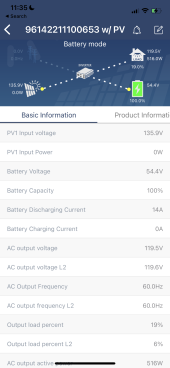dhy4buva
New Member
Has anyone tried mixing monofacial and bifacial panels in the same string? As a newb, I'm wondering if I've badly under-logic-ed this one. All I've seen online / on the forums about mixing panels is that 1) It's generally not advised 2) If you must do it, make sure the operating voltages and currents are close -- in my reading, mostly out of concern for efficiency, not necessarily major problems.
Background: I'm needing to add PV power to my system (EG4 6000ex) and the closest spec match to my existing 6s2p array of Aptos DNA-120-MF26-370W appears to be the Boviet 370W Bifacial BVM66100-370-HC-BF. The Aptos panels of the identical item number that I can purchase today are of a different spec for some reason and more expensive than the Boviets. So I bought the Boviets.
I was just on the phone with Signature Solar tech support to get some last minute details cleared up before wiring everything up this morning and got an unexpected statement from the tech saying that they don't recommend mixing monofacial and bifacial panels. Not sure why I didn't just know this caveat (went back and googled around to see if I just missed this detail, found nothing), but anyhow, I did not know this. The tech said that the resistance of the bifacial panels would be higher than the monofacial panels and therefore the current would backflow into the bifacials...? Doesn't really make sense to me, but I'm not an electrical engineer. Seems to me that the resistance of dissimilar makes of panels would likely always be different in some way--but no one mentions this as a problem that I've seen. Can anyone corroborate or defy the logic the tech gave?
At any rate, now I'm reticent to try this config at all. My questions now are:
1. Would mounting the additional bifacials with minimal rear-light access (at the cost of bifacial gain), remedy this resistance phenomenon?
2. Why didn't I think of this problem before?
3. Can anyone else think of a way to get these panels integrated into the system without running a separate charge controller?
Thanks, all.
Danny
Background: I'm needing to add PV power to my system (EG4 6000ex) and the closest spec match to my existing 6s2p array of Aptos DNA-120-MF26-370W appears to be the Boviet 370W Bifacial BVM66100-370-HC-BF. The Aptos panels of the identical item number that I can purchase today are of a different spec for some reason and more expensive than the Boviets. So I bought the Boviets.
Aptos DNA-120-MF26-370W | Boviet 370W Bifacial BVM66100-370-HC-BF | |
Maximum Power Current (Imp) | 10.76 A | 10.96 A |
Maximum Power Voltage (Vmp) | 34.40 V | 33.81 V |
Short Circuit Current (Isc) | 11.29 A | 11.54 A |
Open Circuit Voltage (Voc) | 41.90 V | 40.56 V |
Bifacial Power Gain 10% | N/A | 407 W |
Bifacial Power Gain 20% | N/A | 444 W |
I was just on the phone with Signature Solar tech support to get some last minute details cleared up before wiring everything up this morning and got an unexpected statement from the tech saying that they don't recommend mixing monofacial and bifacial panels. Not sure why I didn't just know this caveat (went back and googled around to see if I just missed this detail, found nothing), but anyhow, I did not know this. The tech said that the resistance of the bifacial panels would be higher than the monofacial panels and therefore the current would backflow into the bifacials...? Doesn't really make sense to me, but I'm not an electrical engineer. Seems to me that the resistance of dissimilar makes of panels would likely always be different in some way--but no one mentions this as a problem that I've seen. Can anyone corroborate or defy the logic the tech gave?
At any rate, now I'm reticent to try this config at all. My questions now are:
1. Would mounting the additional bifacials with minimal rear-light access (at the cost of bifacial gain), remedy this resistance phenomenon?
2. Why didn't I think of this problem before?
3. Can anyone else think of a way to get these panels integrated into the system without running a separate charge controller?
Thanks, all.
Danny
Last edited:



